NEET Previous Year Questions (2014-2024): The d & f-Block Elements | Chemistry Class 12 PDF Download
2024
Q1: 'Spin only' magnetic moment is same for which of the following ions?
A. Ti3+
B. Cr2+
C. Mn2+
D. Fe2+
E. Sc3+
Choose the most appropriate answer from the options given below.
(a) B and D only
(b) A and E only
(c) B and C only
(d) A and D only (NEET 2024)
Ans: (a)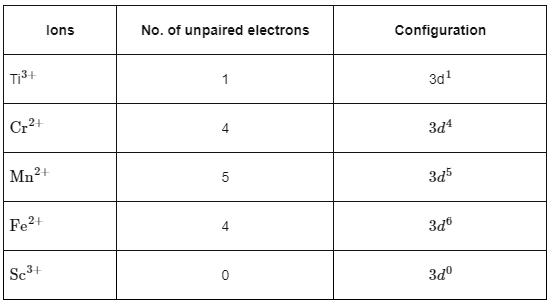 Spin only magnetic moment is given by
Spin only magnetic moment is given by 
∴ Cr2+ and Fe2+ will have same spin only magnetic moment.
Q2: Given below are two statements :
Statement I: Both [Co(NH3)6]3+ and [CoF6]3− complexes are octahedral but differ in their magnetic behaviour.
Statement II: [Co(NH3)6]3+ is diamagnetic whereas [CoF6]3− is paramagnetic.
In the light of the above statements, choose the correct answer from the options given below:
(a) Both Statement I and Statement II are true
(b) Both Statement I and Statement II are false
(c) Statement I is true but Statement II is false
(d) Statement I is false but Statement II is true (NEET 2024)
Ans: (a)
Q3: The E∘ value for the Mn3+/Mn2+ couple is more positive than that of Cr3+/Cr2+ or Fe3+/Fe2+ due to change of
(a) d5 to d4 configuration
(b) d5 to d2 configuration
(c) d4 to d5 configuration
(d) d3 to d5 configuration (NEET 2024)
Ans: (c)
Electronic configuration of 
Electronic configuration of 
Electronic configuration of 
Electronic configuration of 
As Mn3+ from d4 configuration goes to more stable d5 configuration (Half filled), due to more exchange energy in d5 configuration.
Q4: The pair of lanthanoid ions which are diamagnetic is
(a) Ce4+ and Yb2+
(b) Ce3+ and Eu2+
(c) Gd3+ and Eu3+
(d) Pm3+ and Sm3+ (NEET 2024)
Ans: (a)
Magnetic moment 
n ↣ number of unpaired electrons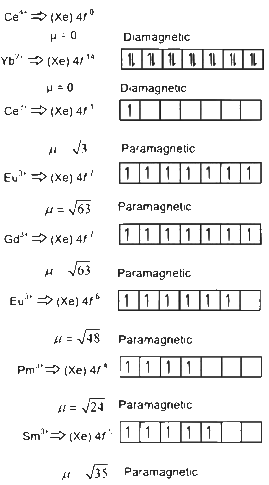
Hence Ce4+ and Yb2+ are only diamagnetic.
Q5: During the preparation of Mohr's salt solution (Ferrous ammonium sulphate), which of the following acid is added to prevent hydrolysis of Fe2+ ion?
(a) dilute hydrochloric acid
(b) concentrated sulphuric acid
(c) dilute nitric acid
(d) dilute sulphuric acid (NEET 2024)
Ans: (d)
Mohr's salt is the ammonium iron(II) sulfate, with the chemical formula (NH4)2Fe(SO4)2⋅6H2O. It is known for its stability compared to the other iron(II) salts which tend to readily oxidize to iron(III) salts when exposed to the air. To prevent the oxidation and hydrolysis of the Fe2+ ion during the preparation of Mohr's salt, an acid is added. This acid serves several purposes: it maintains the acidic environment necessary to prevent hydrolysis, aids in the solubilization of iron(II) sulfate, and minimizes the oxidation of Fe2+ ions to Fe3+.
The options provided give four different types of acids, from which one needs to be selected for the preparation of this salt. We can evaluate them based on their appropriateness:
- Dilute Hydrochloric Acid: While capable of maintaining a low pH to prevent oxidation, HCl can potentially introduce chloride ions (Cl−), which can form complexes with iron, changing the composition of the solution.
- Concentrated Sulphuric Acid: This choice is too strong and can lead to excessive acidity as well as potential safety issues during handling and dilution. It is unnecessary for this application.
- Dilute Nitric Acid: Nitric acid is an oxidizing agent and can promote the oxidation of Fe2+ to Fe3+, which is undesirable in the preparation of Mohr's salt.
- Dilute Sulphuric Acid: This is a very common choice since it helps maintain the stability of the Fe2+ ion without contributing extraneous ions that could form undesired complexes or products. Moreover, it keeps the solution acidic, helping prevent oxidation and hydrolysis, while not introducing any oxidizing characteristics.
Given these considerations, the best choice for preventing hydrolysis of the Fe2+ ion during the preparation of Mohr's salt is Dilute Sulphuric Acid (Option D). This is because it maintains the suitable acidic conditions needed for stabilizing the ferrous ion and does not interfere with the redox stability of the iron by providing an oxidative chemical environment.
2023
Q1: The stability of Cu2+ is more than Cu+ salts in aqueous solution due to (NEET 2023)(a) First ionisation enthalpy
(b) Enthalpy of atomization
(c) Hydration energy
(d) Second ionisation enthalpy
Ans: (c)

The stability of Cu²⁺ is higher than Cu⁺ in aqueous solutions primarily due to the hydration energy.
Hydration energy refers to the energy released when an ion is surrounded by water molecules. Since Cu²⁺ is a highly charged ion, it attracts water molecules more strongly compared to Cu⁺, which results in more hydration energy being released when Cu²⁺ is hydrated.
The increased hydration energy stabilizes the Cu²⁺ ion, making it more stable than Cu⁺ in aqueous solutions.
Q2: Which of the following statements is INCORRECT? (NEET 2023)
A. All the transition metals except scandium form MO oxides which are ionic.
B. The highest oxidation number corresponding to the group number in transition metal oxides is attained in Sc2O3 to Mn2O7.
C. Basic character increases from V2O3 to V2O3 to V2O5.
D. V2O4 dissolves in acids to give VO₄³⁻ salts.
E. CrO is basic but Cr2O3 is amphoteric.
Choose the correct answer from the options given below:
(a) A and E only
(b) B and D only
(c) C and D only
(d) B and C only
Ans: (c)
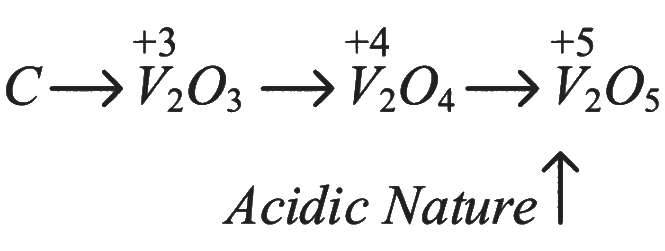
Statement A: "All the transition metals except scandium form MO oxides which are ionic."
Correct: Most transition metals form ionic oxides, except scandium, which forms a covalent oxide (Sc₂O₃).
Statement B: "The highest oxidation number corresponding to the group number in transition metal oxides is attained in Sc₂O₃ to Mn₂O₇."
Correct: The highest oxidation states of transition metals generally correspond to their group numbers, as seen in Sc₂O₃ to Mn₂O₇.
Statement C: "Basic character increases from V₂O₃ to V₂O₄ to V₂O₅."
Incorrect: As the oxidation state increases from +3 in V₂O₃ to +5 in V₂O₅, the acidic character increases and basic character decreases.
Statement D: "V₂O₄ dissolves in acids to give VO₃⁻ salts."
Incorrect: V₂O₄ does not dissolve in acids to form VO₃⁻ salts; V₂O₅ does.
Statement E: "CrO is basic but Cr₂O₃ is amphoteric."
Correct: CrO is basic, while Cr₂O₃ is amphoteric, reacting with both acids and bases.
The incorrect statements are C and D
2022
Q1: Given below are two statements : (NEET 2022)
Statement I : Cr2+ is oxidising and Mn3+ is reducing in nature.
Statement II : Sc3+ compounds are repelled by the applied magnetic field.
In the light of the above statements,
choose the most appropriate answer from the options given below :
(a) Statement I is incorrect but Statement II is correct
(b) Both Statement I and Statement II are correct
(c) Both Statement I and Statement II are incorrect
(d) Statement I is correct but Statement II is incorrect
Ans: (a)
Statement I: Cr²⁺ is oxidizing and Mn³⁺ is reducing in nature.
- Cr²⁺ is reducing, not oxidizing, as it can easily lose an electron to become Cr³⁺.
- Mn³⁺ is oxidizing, not reducing, because it can gain an electron to become Mn²⁺.
- Conclusion: Statement I is incorrect.
Statement II: Sc³⁺ compounds are repelled by the applied magnetic field.
- Sc³⁺ has no unpaired electrons, so it is diamagnetic and will be repelled by a magnetic field.
- Conclusion: Statement II is correct.
The correct answer is (a) Statement I is incorrect but Statement II is correct.
2021
Q1: Zr (Z=40) and Hf (Z=72) have similar atomic and ionic radii because of: (NEET 2021)
(a) lanthanoid contraction
(b) having similar chemical properties
(c) belonging to same group
(d) diagonal relationship
Ans: (a)
- Hf is a post lanthanoid element. Due to presence of 4f-orbitals which have poor shielding effect, the effective nuclear charge on valence shell electrons is more which result in the decrease of the size of Hf. This effect is known as lanthanoid contraction.
- The almost identical radii of Zr (160 pm) and Hf (159 pm) is a consequence of the lanthanoid contraction.
Q2: The incorrect statement among the following is : (NEET 2021)
(a) Lanthanoids are good conductors of heat and electricity.
(b) Actinoids are highly reactive metals, especially when finely divided.
(c) Actinoid contraction is greater for element-to-element than Lanthanoid contraction.
(d) Most of the trivalent Lanthanoid ions are colourless in the solid state.
Ans: (d)
- Most trivalent lanthanoid ions are colored in both the solid state and in solution due to the presence of partially filled f-orbitals, which allow for electronic transitions that absorb visible light. For example, Ce³⁺ and Pr³⁺ ions are colorful. Therefore, the statement that they are colorless in the solid state is incorrect.
Q3: Which of the following reactions is the metal displacement reaction? Choose the right option. (NEET 2021)
(a) 
(b) 
(c) 
(d) 
Ans: (c)
- Both reactions (a) and (b) are examples of decomposition reactions.
- Reactions (c) and (d), both are examples of displacement reactions, while reaction (c) is an example of metal displacement reaction n in which a more reactive metal displaces/replaces the less reactive metal.
2020
Q1: Identify the incorrect statement. ( NEET 2020)
(a) Interstitial compounds are those that are formed when small atoms like H, C or N are trapped inside the crystal lattices of metals.
(b) The oxidation states of chromium in CrO24- and Cr2O72- are not the same.
(c) Cr2+(d4) is a stronger reducing agent than Fe2+(d6) in water.
(d) The transition metals and their compounds are known for their catalytic activity due to their ability to adopt multiple oxidation states and to form complexes.
Ans: (b)
Oxidation state of Cr in CrO42- and Cr2O72- is + 6.
2018
Q1: Which one of the following ions exhibits d-d transition and paramagnetism as well?
(a) CrO42-
(b) Cr2O72–
(c) MnO4-
(d) MnO42- (NEET 2018)
Ans: (d)
In CrO42- Cr+6 (n = 0) diamagnetic
In Cr2O72– Cr+6 (n = 0) diamagnetic
In MnO4- Mn+7 (n = 0) diamagnetic
In MnO42- Mn+6 (n = 1) paramagnetic
In MnO42-, one unpaired electron(n) is present in d-orbital so, d-d transition is possible.
Q2: Match the metal ions given in Column I with the spin magnetic moments of the ions given in Column II and assign the correct code :
(NEET 2018)
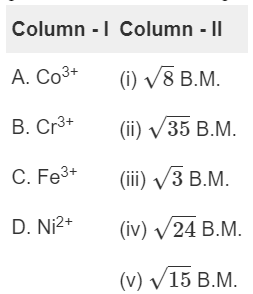
(a) 
(b) 
(c) 
(d) 
Ans: (a)
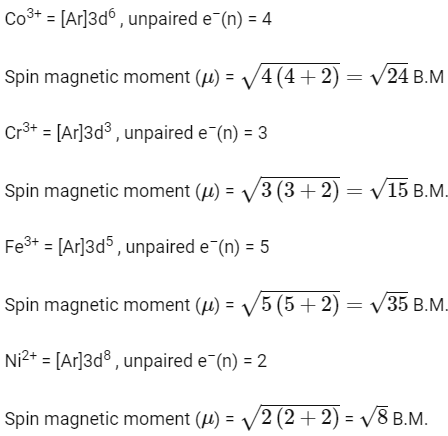
2017
Q1: Name the gas that can readily decolourise acidified KMnO4 solution : (NEET 2017)
(a) SO2
(b) NO2
(c) P2O5
(d) CO2
Ans: (a)
Acidified KMnO4 is a strong oxidizing agent thus, among the given options which readily undergoes oxidation with KMnO4 will decolourise it. CO2, NO2 and P2O5 are already in their highest oxidation state while SO2 can further oxidize with KMnO4 to give sulphate ions.
2MnO4– + 5SO2 + 2H2O
Q2: HgCl2 and I2 both when dissolved in water containing I– ions the pair of species formed is : (NEET 2017)
(a) HgI2, I–
(b) HgI42-, I3-
(c) Hg2I2, I–
(d) HgI2, I¯3
Ans: (b)
HgCl2 + 4I– (aq)
I2(s) + I– (aq)
Q3: The reason for greater range of oxidation states in actinoids is attributed to :- (NEET 2017)
(a) actinoid contraction
(b) 5f, 6d and 7s levels having comparable energies
(c) 4f and 5d levels being close in energies
(d) the radioactive nature of actinoids
Ans: (b)
Minimum or comparable energy gap between 5f, 6d and 7s subshell makes electron excitation easier, hence there is a greater range of oxidation states in actinoids.
2016
Q1: Which one of the following statements is correct when SO2 is passed through acidified K2Cr2O7 solution? (NEET 2016)
(a) Green Cr2(SO4)3 is formed.
(b) The solution turns blue
(c) The solution is decolourized.
(d) SO2 is reduced.
Ans: (a)
K2Cr2O7 + H2SO4 + 3SO2 → K2SO4 + Cr2(SO4)3 (Green) + H2O
Q2: The electronic configurations of Eu (Atomic No. 63) Gd (Atomic No. 64) and Tb (Atomic No. 65) are : (NEET 2016)
(a) [Xe]4f7 6s2, [Xe]4f75d16s2 and [Xe]4f96s2
(b) [Xe]4f7 6s2, [Xe]4f8 6s2 and [Xe]4f8 5d16s2
(c) [Xe]4f6 5d16s2, [Xe]4f7 5d16s2 and [Xe]4f9 5d16s2
(d) [Xe]4f6 5d16s2, [Xe]4f7 5d16s2 and [Xe]4f8 5d16s2
Ans: (a)
Eu (63) = [Xe] 4f7 6s2
Gd (64) = [Xe] 4f7 5d1 6s2
Tb (65) = [Xe] 4f9 6s2
Q3: Which one of the following statements related to lanthanoids is incorrect.
(a) Europium shows + 2 oxidation state.
(b) The basicity decreases as the ionic radius decreases from Pr to Lu.
(c) All the lanthanides are much more reactive than aluminium.
(d) Ce(+4) solutions are widely used as oxidizing agent in volumetric analysis. (NEET 2016)
Ans: (c)
The first few members of the lanthanoid series are quite reactive, almost like calcium. However, with increasing atomic number, their behavior becomes similar to that of aluminium.
2015
Q1: Which of the following processes does not involve oxidation of iron ? (AIPMT 2015 Cancelled Paper )
(a) Liberation of H2 from steam by iron at high temperature
(b) Rusting of iron sheets
(c) Decolourization of blue CuSO4 solution by iron
(d) Formation of Fe(CO)5 from Fe
Ans: (d)
Q2: Because of lanthanoid contraction, which of the following pairs of elements have nearly same atomic radii ? (Numbers in the parenthesis are atomic numbers). (AIPMT 2015 Cancelled Paper )
(a) Zr (40) and Ta (73)
(b) Ti (22) and Zr (40)
(c) Zr (40) and Nb (41)
(d) Zr (40) and Hf (72)
Ans: (d)
Q3: Magnetic moment 2.84 B.M. is given by (At. nos. Ni = 28, Ti = 22, Cr = 24, Co = 27)
(a) Cr2+
(b) Co2+
(c) Ni2+
(d) Ti3+ (AIPMT 2015 Cancelled Paper )
Ans: (c)

Cr2+ – [Ar]3d44s0 , 4 unpaired electrons
Co2+ – [Ar]3d74s0 , 3 unpaired electrons
Ni2+ – [Ar]3d8 4s0 , 2 unpaired electrons
Ti3+ – [Ar]3d14s0 , 1 unpaired electron
Q4: Gadolinium belongs to 4f series. Its atomic number is 64. Which of the following is the correct electronic configuration of gadolinium
(a) [Xe]4f95s1
(b) [Xe]4f75d16s2
(c) [Xe]4f65d26s2
(d) [Xe]4f86d2 (NEET / AIPMT 2015)
Ans: (b)
Gd(64) = [Xe]4f75d16s2
Q5: Assuming complete ionisation, same moles of which of the following compounds will require the least amount of acidified KMnO4 for complete oxidation
(a) FeSO3
(b) FeC2O4
(c) Fe(NO2)2
(d) FeSO4 (NEET / AIPMT 2015)
Ans: (d)
FeSO4 will require the least amount of acidified KMnO4 for complete oxidation.
2014
Q1: Reason of lanthanoid contraction is : (NEET 2014)
(a) Decreasing nuclear charge
(b) Decreasing screening effect
(c) Negligible screening effect of 'f ' orbitals
(d) Increasing nuclear charge
Ans: (c)
The shape of f-orbitals is very much diffused and they have poor shielding effect. The effective nuclear charge increases which causes the contraction in the size of electron charge cloud. This contraction in size is quite regular and known as lanthanoid contraction.
Q2: The reaction of aqueous KMnO4 with H2O2 in acidic conditions gives : (NEET 2014)
(a) Mn2+ and O3
(b) Mn4+ and MnO2
(c) Mn4+ and O2
(d) Mn2+ and O2
Ans: (d)
Hydrogen peroxide is oxidised to H2O and O2.
2KMnO4 + 3H2SO4 + 5H2O2
Thus, Mn2+ and O2 are produced.
|
108 videos|287 docs|122 tests
|
FAQs on NEET Previous Year Questions (2014-2024): The d & f-Block Elements - Chemistry Class 12
| 1. What are the key properties of d-block elements? |  |
| 2. How do d-block elements differ from f-block elements? |  |
| 3. Why are transition metals important in biological systems? |  |
| 4. What are some common oxidation states of transition metals? |  |
| 5. How do the properties of d-block elements affect their use in catalysts? |  |


















